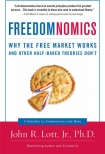Freedomnomics: Why the Free Market Works and Other Half-Baked Theories Don't John Jr. (the dot read aloud .txt) 📖

- Author: John Jr.
Book online «Freedomnomics: Why the Free Market Works and Other Half-Baked Theories Don't John Jr. (the dot read aloud .txt) 📖». Author John Jr.
Annoyed that 527 groups still allow citizens a roundabout way to donate to their favored candidates, campaign finance reformers have introduced legislation to further restrict their activities, such as the 527 Reform Act of 2005. Even if approved, such “reforms” will not abolish money from politics; they’ll just once again change its route. The National Rifle Association (NRA) recently foreshadowed how interest groups might react to all these restrictions when it looked into purchasing a TV or radio station. The group, perhaps, could thereby avoid myriad campaign finance restrictions by claiming the status of a media organization.
While campaign spending continues to grow rapidly, we must keep the overall figures in perspective. In 2004, total campaign spending for all House, Senate, and presidential candidates amounted to $2.17 billion while overall federal government spending was about $2.23 trillion. 53 Thus campaign expenditures totaled roughly one-thousandth of what the federal government spent. With trillions of dollars a year at stake, is that really too much to spend in debating how that money should be allocated? We must expect a lot of people will spend large amounts of cash to influence the selection of the people who control such huge amounts of money. But for those of you who think $2.17 billion is an outrageous sum, consider this: Proctor & Gamble spent $3.9 billion on advertising in that same year.54
The Myth of Double-Giving
In the popular mind, one of the quintessential examples of influence-peddling is the phenomenon of “double-giving”—donors giving funds to both candidates in a political race to ensure that whoever is elected will be in their debt.
Judging by media articles and reports from various interest groups, the phenomenon of double giving is a widespread, cynical practice that illustrates the need for campaign finance reform. The AP reported that the practice “isn’t all that unusual” in an August 2006 article entitled, “No need to choose sides, some donors give to both gubernatorial candidates.” 55 According to the Center for Responsive Politics, “double-giving [by PACs] is the classic example of pragmatic political investment. It shows that there is little ideological content behind the contributions. They just want to give to the winner with the hope that it will pay off legislatively.”56 A study by Public Campaign, an advocacy organization for campaign finance regulations, found that “forty-seven companies and organizations that appear on the donor list of three or more presidential candidates gave at least $50,000 overall. Forty-five of these companies are playing the entire field, showing up on all four of the front-runners’ donor lists.”57
This indeed seems cynical. Not many donors can really believe that both the Democrat and the Republican candidate in a race are equally good. And even if this were the case, why would donors waste their money donating to both candidates instead of moving their donations to other races where politicians differed in a more substantial way? The only explanation for double-giving seems to be to buy influence.
Yet, this entire image of double giving is a complete myth.58 In fact, it is impossible for corporations to practice double-giving in any federal races at all, since they are legally banned from donating to federal candidates whether in House, Senate, or presidential races. Similar restrictions also exist in many states for state elections.59
What is often lazily reported as “corporate” donations for a federal race is really the sum-total of donations by a corporation’s individual employees. And there is a perfectly logical explanation why we would see corporate employees donating to both parties: most companies employ both Republicans and Democrats.
As for PACs, they almost never double-give. Ron Pearson of the Conservative Victory Fund reports, “I cannot think of one case, and I have carefully studied all the conservative PAC contributions, where a conservative PAC has simultaneously given to more than one candidate in a race.”60 Likewise, Ann Murry of the American Medical Association notes, “I couldn’t say with complete certainty that we have never done that, but it sure would seem weird if we did.” Indeed, there is certainly good cause for viewing double-giving as “weird.” According to Chris Farrell, the director of the National Association of Retired Federal Employees’ PAC, “contributions to both candidates in a race is the same as contributions to neither.” The purpose of double-giving is ostensibly to ensure that whoever wins the election will feel indebted to the donor, but it’s hard to imagine how a candidate could perceive such a debt to a PAC that had also given money to his opponent. As Farrell remarked, “it’s not like these candidates are stupid.”
Even in the few instances when PACs do double-give, the donations are usually not made for the cynical reason claimed by campaign finance proponents. Mary Anne Karpinsky of the Association of Trial Lawyers of American affirms that her organization only engages in double-giving “in one in a thousand races,” and that “the only time





Comments (0)